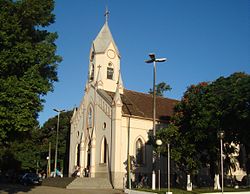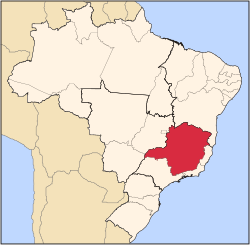This article needs additional citations for verification .(May 2017) |
Alterosa | |
|---|---|
 | |
 Location of Alterosa in Minas Gerais | |
| Coordinates: 21°15′S46°08′W / 21.250°S 46.133°W | |
| Country | |
| Region | Southeast |
| State | |
| Founded | 17 December 1938 |
| Government | |
| • Mayor | Hermes de Souza Silva (PSB; –2020) |
| • Vice-mayor | Abimael |
| Area | |
• Total | 366.101 km2 (141.352 sq mi) |
| Elevation | 848 m (2,782 ft) |
| Population (2020 [2] ) | |
• Total | 14,517 |
| Demonym | Alterosense |
| Website | www |
Alterosa is a Brazilian municipality in the South of the state of Minas Gerais. According to latest data from IBGE (2020), its population is estimated to be 14,517. The inhabitants of the city usually travel to the nearest city, Alfenas, when they are in need of more sophisticated supplies.
Contents
- History
- Geography
- Districts
- Economy
- Education
- Schools
- Events
- Communication
- Financial institutions
- References
- External links
Alterosa was founded on 17 December 1938.




